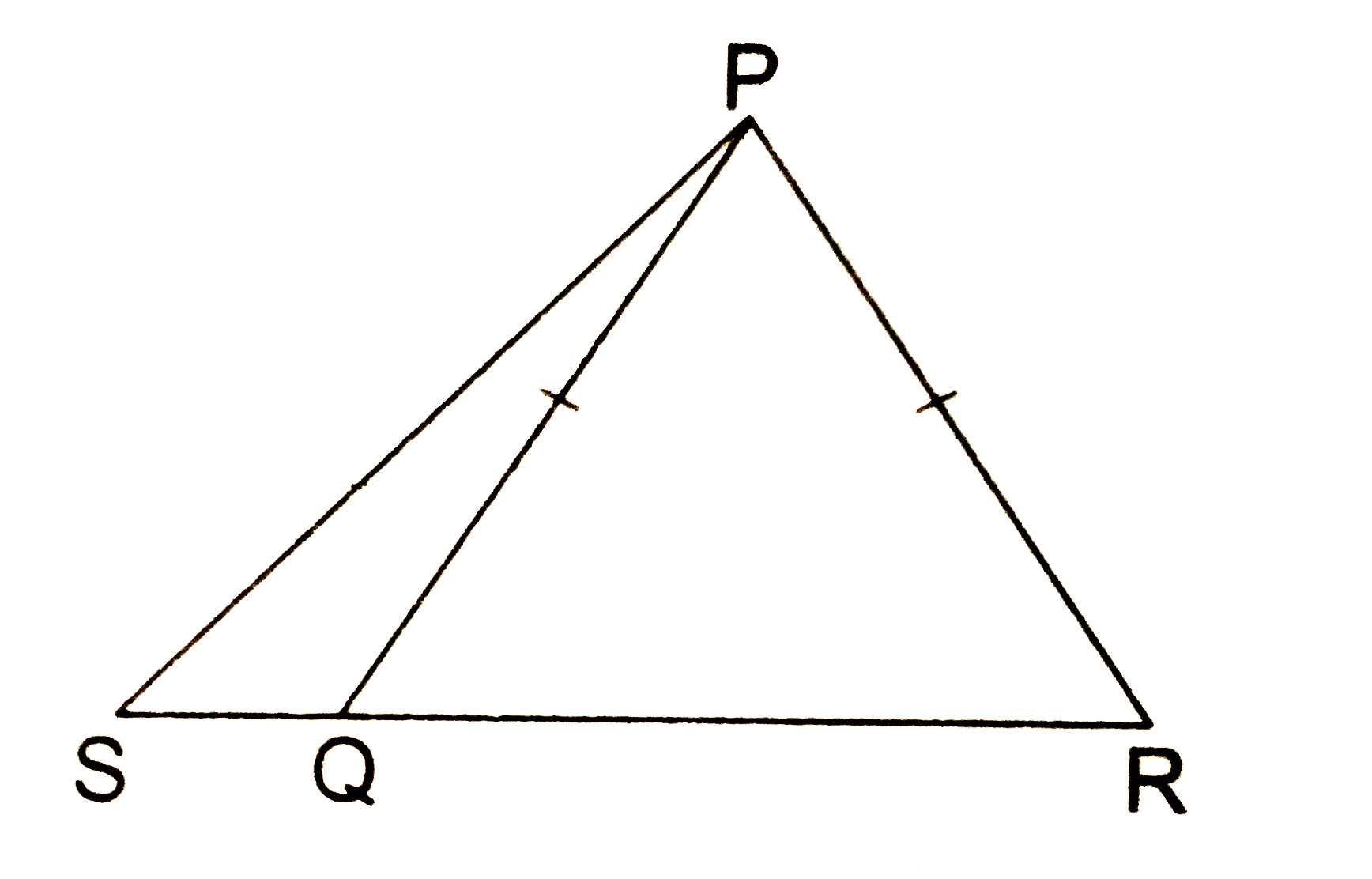If S is a point on side PQ of a ΔPQR such that PS=QS=RS, then
PR⋅QR=RS2
QS2+RS2=QR2
PR2+QR2=PQ2
PS2+RS2=PR2
The correct Answer is:C
To solve the problem, we need to analyze the given triangle ΔPQR with point S on side PQ such that PS=QS=RS.
1. Draw the Triangle:
- Start by sketching triangle PQR with point S on side PQ.
2. Label the Segments:
- Mark the lengths such that PS=QS=RS=x (where x is some length).
3. Identify Isosceles Triangles:
- Notice that triangle PSR is isosceles because PS=RS.
- Similarly, triangle QSR is also isosceles because QS=RS.
4. Apply the Isosceles Triangle Property:
- In triangle PSR, since PS=RS, the angles opposite these sides are equal:
- Let ∠1=∠P.
- In triangle QSR, since QS=RS, the angles opposite these sides are equal:
- Let ∠2=∠Q.
5. Use the Angle Sum Property of Triangle:
- For triangle PQR, the sum of the angles is:
∠P+∠Q+∠R=180∘
- Substitute ∠P and ∠Q with ∠1 and ∠2:
∠1+∠2+∠R=180∘
6. Express ∠R:
- From the previous step, we can express ∠R as:
∠R=180∘−(∠1+∠2)
7. Substituting Values:
- Since ∠1=∠P and ∠2=∠Q, we can write:
∠R=180∘−(∠P+∠Q)
- This implies that ∠R=90∘.
8. Conclusion:
- Since ∠R=90∘, triangle PQR is a right triangle.
- By the Pythagorean theorem, we have:
PQ2=PR2+QR2
Final Result:
The relationship established is that PQ2=PR2+QR2.
- Start by sketching triangle PQR with point S on side PQ.
- Mark the lengths such that PS=QS=RS=x (where x is some length).
- Notice that triangle PSR is isosceles because PS=RS.
- Similarly, triangle QSR is also isosceles because QS=RS.
- In triangle PSR, since PS=RS, the angles opposite these sides are equal:
- Let ∠1=∠P.
- In triangle QSR, since QS=RS, the angles opposite these sides are equal:
- Let ∠2=∠Q.
- For triangle PQR, the sum of the angles is:
∠P+∠Q+∠R=180∘
- Substitute ∠P and ∠Q with ∠1 and ∠2:
∠1+∠2+∠R=180∘
- From the previous step, we can express ∠R as:
∠R=180∘−(∠1+∠2)
- Since ∠1=∠P and ∠2=∠Q, we can write:
∠R=180∘−(∠P+∠Q)
- This implies that ∠R=90∘.
- Since ∠R=90∘, triangle PQR is a right triangle.
- By the Pythagorean theorem, we have:
PQ2=PR2+QR2
The relationship established is that PQ2=PR2+QR2.
Topper's Solved these Questions
Similar Questions
Knowledge Check
- Question 1 - Select One
If S is any point on the side QR of a ΔPQR, then
APQ+QR+RP>2PSBPQ+QR+RP<2PSCPQ+QR+RP=3PSDNone of these - Question 2 - Select One
S and U are two points on the side PQ of ΔPQR , such that QU=PS . If ST||QR and UV∣∣PR , then
ATV||PQBTV⊥PQCTV and PQ intersect at 60∘DTV and PQ intersect at 45∘ - Question 3 - Select One
In a ΔPQR, S in a point on side PQ and T is a point on side PR such that ST II QR PSSQ=35 and PR = 28 cm. What is the value of PT?
A12.5 cmB17.5 cmC10.5 cmD13.5 cm
S is any point on side QR of a ΔPQR. Show that PQ+QR+RP>2PS.
View SolutionIn the given figure, Q is a point on the side SR of ΔPSR such that PQ = PR. Prove that PS>PQ.
 View Solution
View SolutionS in any point on side QR of a ΔPQR.ShowtˆPQ + QR+RP gt 2PS.
View SolutionIf S is the mid-point of side QR of a ΔPQR, then prove that PQ+PR=2PS.
View SolutionIn ΔPQR, if S is any point on side QR, show that PQ+QR+RP>2PS.
View Solution

